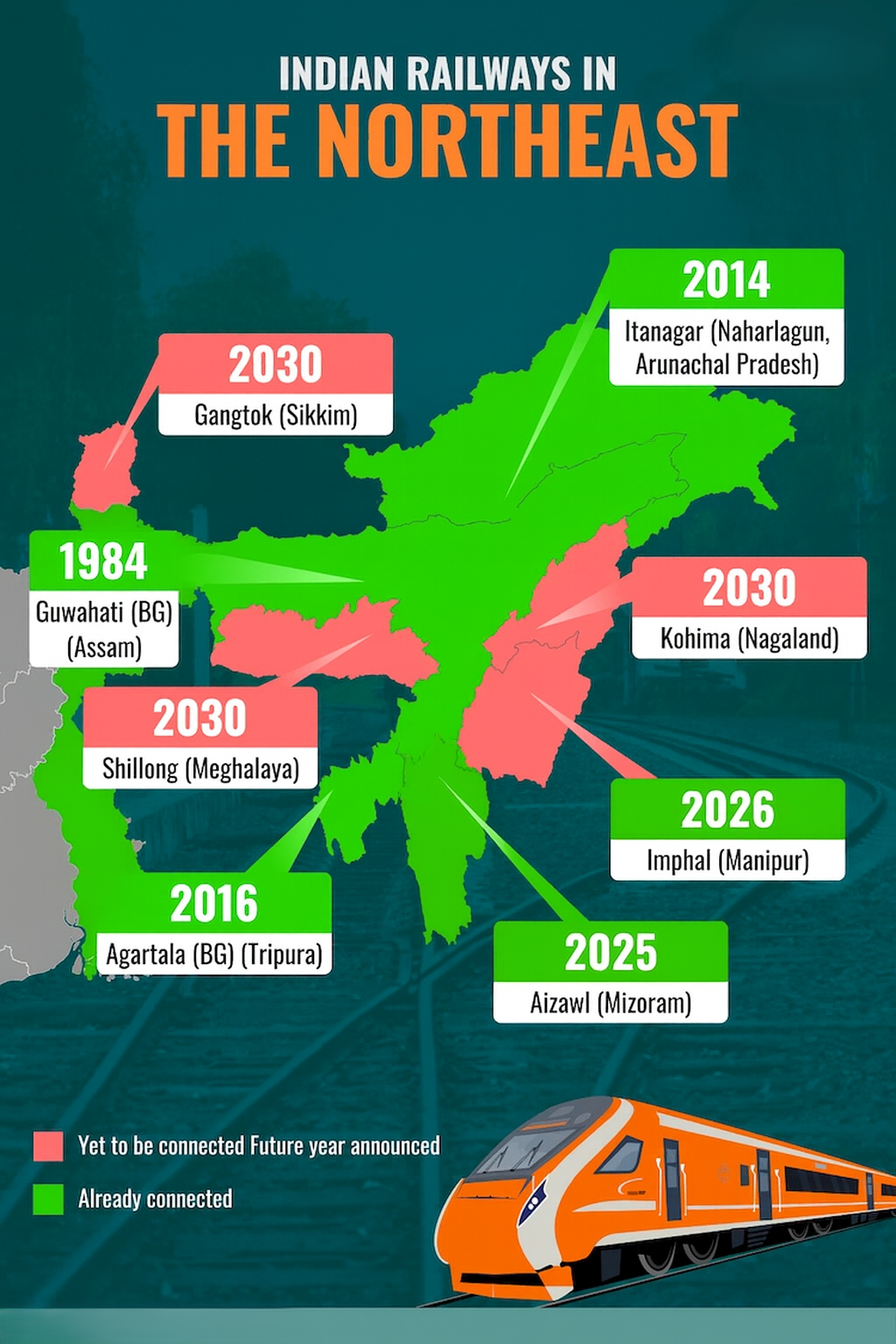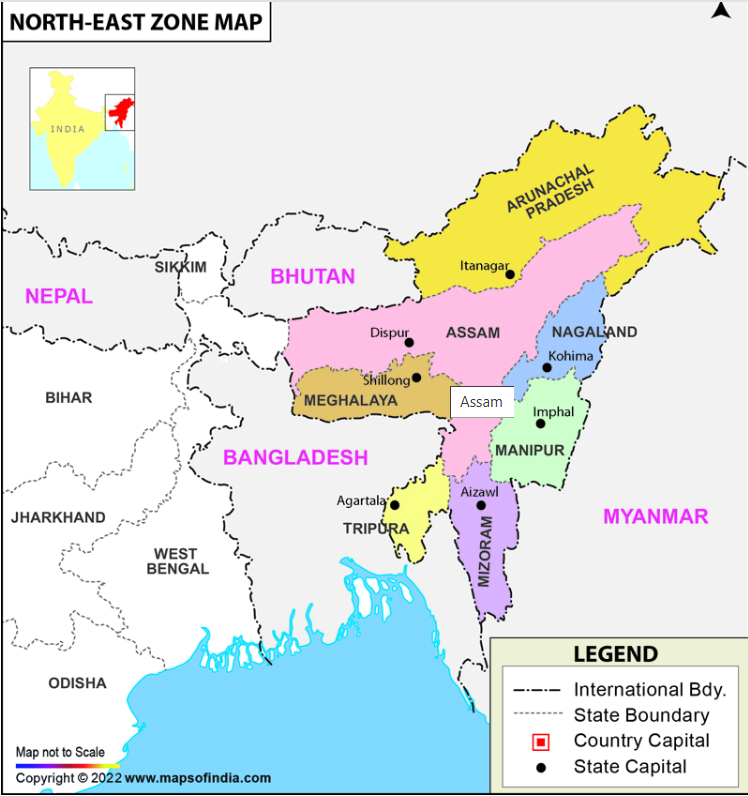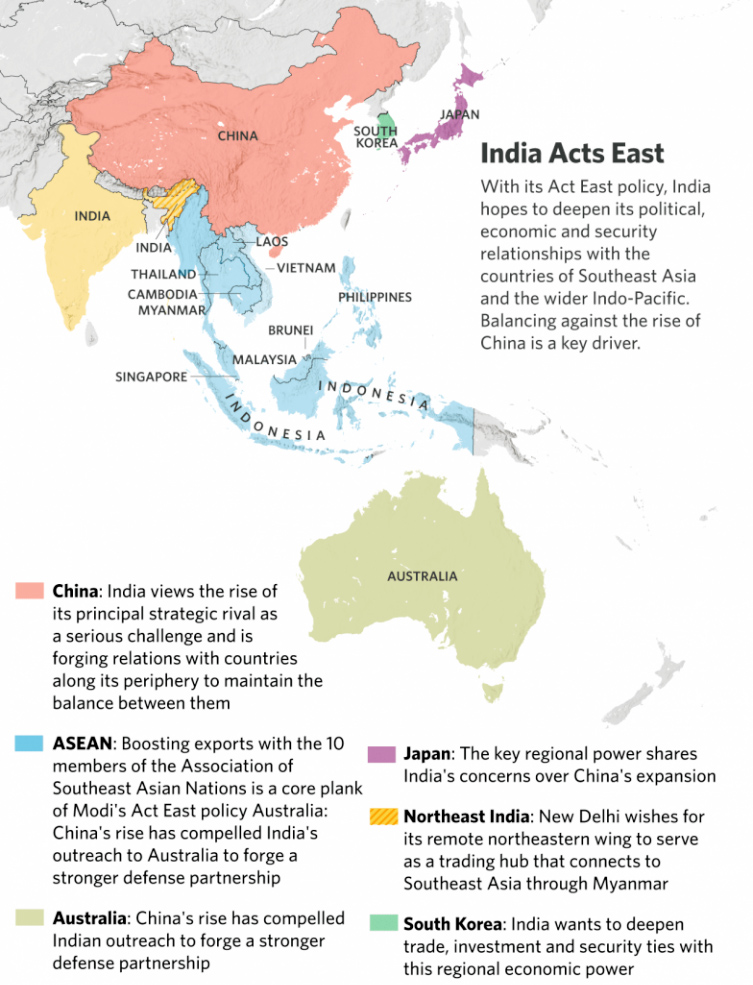Governance
Enhancing Northeast Connectivity for Act East Policy
- 05 Aug 2025
- 11 min read
|
For Prelims: Northeast region, Siliguri Corridor, India's Act East Policy, Sittwe Port, India–Myanmar–Thailand Trilateral Highway For Mains:Connectivity Challenges in North Eastern India, Act East Policy and Role of Northeast India |
Source: TH
Why in News?
India’s Act East Policy aims to transform the North-East into a gateway to Southeast Asia. The commissioning of the 51.38-km Bairabi–Sairang rail line in Mizoram is a key step toward this.
Northeast India’s Infrastructure Revolution: 11 Years of Connectivity and Growth (2014-2025)
- Infrastructure Transformation: The region has seen remarkable development in roads, railways, airports, and digital networks under initiatives like the Act East Policy and the North East Special Infrastructure Development Scheme (NESIDS).
- Rail Connectivity: Historic advances have been made in Arunachal Pradesh and Mizoram, including Mizoram receiving its first passenger train in independent India's history. Railway connectivity has also been extended to Manipur and Nagaland.
- The Bairabi–Sairang Rail Project in Mizoram is a key strategic initiative under India’s Act East Policy, aimed at boosting connectivity in the Northeast.
- Originally, Mizoram had only a 1.5 km metre-gauge line linking Bairabi (Kolasib district) to Silchar (Assam).
- Despite challenges like difficult terrain and manpower shortages, the project includes 48 tunnels (totaling 12.85 km) and 142 bridges, and received safety clearance in June 2025.
- The Bairabi–Sairang Rail Project in Mizoram is a key strategic initiative under India’s Act East Policy, aimed at boosting connectivity in the Northeast.
- Inland Waterways: Ro-Ro ferry services have been revived on the Brahmaputra, offering cost-effective cargo transport and boosting economic activity.
- Digital Connectivity: Digital infrastructure has expanded with programs like BharatNet and 4G saturation, connecting remote villages and bridging the digital divide.
- NESIDS Projects: The Government of India sanctioned 90 projects, under NESIDS to upgrade healthcare, education, drinking water, and public infrastructure, with 30 projects already completed.
- Economic Growth and Regional Integration: This infrastructure revolution has improved the quality of life, attracted private investment, and fostered regional development, positioning Northeast India as an important gateway for national and regional integration.
How Does Improving Regional Connectivity in Northeast India Align with India’s Act East Policy?
- Enhanced Diplomatic and Security Ties: Connectivity through projects like the Kaladan Multi-Modal Transit Project, IMT Trilateral Highway and Sairang’s strategic location will complement India’s efforts to strengthen trade and connectivity with ASEAN countries.
- Improved infrastructure fosters stronger ties with Myanmar, and Bangladesh, supporting India's strategic and security objectives in the region.
- Transhipment Hub: The Sairang railhead is poised to become an important transit point for goods moving from Myanmar's Sittwe Port , fostering closer regional economic integration.
- This rail line is a key piece of India’s long-term infrastructure projects designed to link the northeastern states with Southeast Asia.
- Socio-Economic Upliftment: Improved rail connectivity in the North-Eastern Region (NER) (NER) promotes job creation, regional integration, reduces geographical isolation, and links the region with the national mainstream.
- It also promotes better access to education, healthcare, and disaster response, helping bridge developmental disparities between the NER and the rest of India.
What is India’s Act East Policy?
- About: The Act East Policy, launched in November 2014, is an upgraded version of the earlier Look East Policy.
- It is a diplomatic and strategic initiative aimed at strengthening economic, cultural, and defence ties with the Asia-Pacific and Indo-Pacific regions, particularly Southeast Asia.
- Objective: To develop deeper ties with Indo-Pacific countries, enhance economic development in the North Eastern Region (NER), and position it as India’s gateway to Southeast Asia.
- Key Features: Focuses on connectivity, trade, defence, and people-to-people ties through multi-level engagement and proactive diplomacy with ASEAN and Indo-Pacific nations.
India’s Initiatives Promoting NE Connectivity
- PM Gati Shakti National Master Plan
- Act East Policy
- Special Accelerated Road Development Programme for NE (SARDP-NE)
- North East Special Infrastructure Development Scheme (NESIDS)
What are the Key Challenges in Implementing Regional Connectivity Under the India's Act East Policy?
- Geopolitical Challenges: Myanmar Civil Conflict (since 2021) has disrupted the Kaladan Multimodal Transit Transport Project.
- Bangladesh Political Instability (2024) has delayed the Agartala–Akhaura rail link, affecting access to Chittagong Port and regional trade integration.
- Security & Insurgency Risks: Ethnic clashes, e.g., Manipur conflict (2023), and persistent insurgencies deter investment.
- Key projects like Imphal–Moreh Rail Line and Asian Highway 1 are stalled due to regional unrest.
- Inadequate Infrastructure in Northeast India: The NER’s underdeveloped road, rail, and air linkages hinder its potential as a gateway to Southeast Asia under the Act East Policy.
- The Siliguri Corridor ("Chicken’s Neck"), only 22 km wide, is prone to disruption. Frequent floods, landslides, earthquakes, and fragile ecology hinder infrastructure work.
- Local opposition to large-scale projects like dams and mining due to environmental concerns.
- Multi-modal integration remains incomplete, limiting seamless regional connectivity.
- China Factor & Strategic Gaps: Rising Chinese influence in the region and India’s withdrawal from RCEP raise concerns about India's economic engagement in East Asia.
- Limited trade agreements and slow progress on connectivity weaken India’s regional leverage.
What Should Measures be Taken to Enhance Northeast Connectivity Under India’s Act East Policy?
- Strengthened Regional Diplomacy & Connectivity: India must strengthen strategic ties with Myanmar and Bangladesh to fast-track connectivity projects like the Kaladan Multi-Modal Transit Project and Agartala–Akhaura rail link.
- Leveraging regional groupings such as BIMSTEC and BBIN is crucial for enhancing cross-border trade, improving logistics infrastructure, and accessing key maritime hubs like Chittagong Port (Bangladesh) and Sittwe Port (Myanmar).
- Emphasis should also be placed on completing inland connectivity corridors such as the Dimapur–Zubza and Imphal–Moreh railway lines to strengthen India's linkages with ASEAN economies.
- Integrated and Resilient Infrastructure: India must develop multi-modal transport infrastructure (road, rail, air, waterways) under schemes like PM Gati Shakti, Bharatmala, and UDAN to support Act East objectives.
- Infrastructure should be disaster-resilient, tailored to the Northeast’s fragile terrain prone to floods, landslides, and earthquakes.
- Creating alternative connectivity routes is essential to reduce over-dependence on the Siliguri Corridor, ensuring uninterrupted access to Southeast Asian markets.
- Security-Sensitive and Inclusive Development: Connectivity under the Act East Policy must align with counter-insurgency measures, securing infrastructure in border and conflict-prone areas.
- Strengthening peace-building with Myanmar is vital for stable border management.
- Ensuring local participation through Environmental and Social Impact Assessments (ESIA), equitable compensation, and benefit-sharing will promote sustainability, inclusiveness, and regional stability.
- Institutional & Execution Reforms: Effective implementation of the Act East Policy requires governance reforms like single-window clearance for land acquisition and project approvals.
- Promoting PPPs and integrating transport, digital, and energy infrastructure will enhance economic integration and ensure timely execution of projects in the Northeast.
Conclusion
The Northeast is not just India's frontier but also its gateway to Southeast Asia. Unlocking its potential through robust and inclusive connectivity will not only empower the region socio-economically but also strengthen India’s geostrategic standing in the Indo-Pacific. Success lies in balancing infrastructure push with ecological sensitivity, strategic diplomacy, and local cooperation.
|
Drishti Mains Question: Q. Discuss the role of regional connectivity in enhancing India's Act East Policy with reference to the Northeast. What geopolitical challenges impede this vision? |
UPSC Civil Services Examination, Previous Year Questions (PYQs)PrelimsQ.1 The term ‘Regional Comprehensive Economic Partnership’ often appears in the news in the context of the affairs of a group of countries known as (2016) (a) G20 Ans: (b) MainsQ. Cross-border movement of insurgents is only one of the several security challenges facing the policing of the border in North-East India. Examine the various challenges currently emanating across the India- Myanmar border. Also, discuss the steps to counter the challenges. (2019) |









